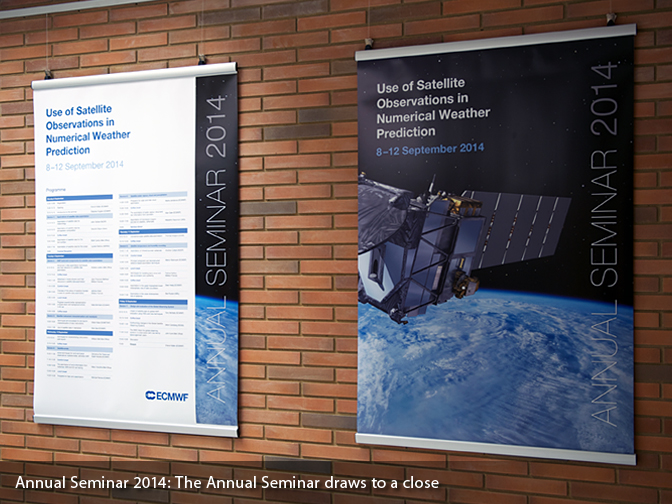

Understanding how satellite data contribute to improving numerical weather prediction
Last Friday saw the end of this year’s edition of the ECMWF Annual Seminar 2014, focusing on The Use of Satellite Observations in NWP, which proved as popular as ever with over 100 scientists from around the world attending. The seminar was held from 8 to 12 September at ECMWF’s headquarters in Reading, UK
Both early-career scientists and experts alike benefited from presentations on the use of satellite data from leading scientists at ECMWF and from around the world. They also enjoyed an opportunity to discuss recent developments in the use of satellite data and the associated data assimilation techniques. The seminar is an important part of ECMWF’s educational activities.
The seminar began with overviews of the use of satellite data in different aspects of NWP. Data assimilation techniques pioneered for atmospheric meteorological analysis are now being successfully applied for climate reanalysis, as well as ocean, land surface and atmospheric composition. The capability to make effective use of satellite observations relies on the quality of the NWP system, in particular the forecast model (dynamics and physics) and the data assimilation. Jean-François Mahfouf and Andrew Lorenc described evolving aspects of both critical to satellite data use, and an interesting debate followed on whether 4D-Var will remain as important in future as it is now. Almost all NWP systems are using a flavour of ensemble data assimilation, and in some the plan now is to move away from the well-established 4D-var approach completely. It is an area of active research at this time, with important implications for the use of satellite data, and it is fair to say there is no consensus as yet.
There are also specific tools needed for satellite data and the state-of-the-art in these was very well presented. Radiative transfer models can handle cloud effects far better now, and there continue to be improvements in spectroscopy, line by line models and models for surface emission. Until recently little attention was given to observation errors, but it was shown by several speakers how critical this is to correct use of observations. Significant progress has been made in more realistic observation errors, including error correlation, for both radiances and atmospheric motion vectors. In addition to this it was shown how space agencies and weather services can work together to better understand systematic errors in satellite data sets. There was agreement that it is important to make calibration traceable to recognised standards.
Substantial progress has been achieved regarding the assimilation of radiances in all weather conditions and at the convective scale, firmly establishing that all-sky assimilation is now a key component of state-of-the-art data assimilations systems. Critical for the value of all-sky assimilation is the influence on the wind field through 4D-var which is key to maintaining impact throughout the forecast.
Excellent presentations were given on observation techniques such as altimeter, scatterometer, lidar and radar. Concern was expressed as to how for example Doppler wind lidar will continue operationally, should the Aeolus demonstration mission be a success. In the past Atmospheric Motion Vectors have had only a small impact, but we now understand far better how to assimilate them and their impact has increased. Many presentations confirmed that hyperspectral infrared and radio occultation are now a core part of the global observing system and are delivering the impact they promised.
Assimilation for the Earth's surface (snow, soil moisture) and the stratosphere/mesosphere present specific challenges and opportunities. It was noted that there are no plans for continued mesospheric observations post SSMIS, even though mesospheric precursors to regime changes in the stratosphere have been demonstrated, which could aid longer range predictability.
The seminar concluded with an examination of the techniques to estimate the overall value of the satellite global observing system and its individual components. The continued importance of conventional observations was emphasised, though even in the northern hemisphere overall satellite data provides by far the largest impact. Finally a gap analysis for the Global Observing System between what we have and what we need was presented, emphasising how useful WMO’s OSCAR database has become. This highlighted several important areas where we need more observations to fully meet the WMO vision for 2025 e.g. for scatterometers to maintain coverage of ocean winds.
ECMWF Director of Research Erland Källén closed the meeting, noting the remarkable progress in satellite data assimilation in the last few years, and the exciting prospects offered at the meeting for the coming decade.
The seminar is part of ECMWF’s educational programme.
Presentations and detailed programme are available online.
Invited experts giving presentations
ECMWF: Alan Geer, Dick Dee, Erland Källén, Giovanna De Chiara, Marco Matricardi, Marta Janiskova, Michael Rennie, Niels Bormann, Saleh Abdalla, Sean Healy, Stephen English, Tony McNally
EUMETSAT: Dieter Klaes
JMA: Masahiro Kazumori
Met Office: Andrew Lorenc, Bill Bell, Brett Candy, John Eyre, Mary Forsythe
Météo-France: Fatima Karbou. Jean-François Mahfouf, Jéröme Vidot,
NERSC: Laurent Bertino
NOAA/NCEP: Andrew Collard, John Derber
NOAA, NASA/GSFC: Mitch Goldberg
NRL: Ben Ruston
UCAR: Thomas Auligné
University of Cologne: Hendrik Elbern
